Our Core Services
Mastering Landing Page Optimization: Data-Driven Approaches for Maximum Results
Do you ever stop and think why some landing pages effortlessly convert visitors into buyers and others fail to even get hold of the most fundamental details of visitors? Landing page optimization is at the very core of this divergence, turning bland web pages into effective conversion machines that fuel business expansion. Most business owners design landing pages but neglect to maximize their potential. This guide demystifies all you need to understand about landing page optimization—from simple principles to sophisticated techniques—to enable you to convert more visitors into meaningful leads and customers.

Table of Content
What is Landing Page Optimization?
Landing page optimization is the methodical process of enhancing items on your landing page to boost conversions. Landing pages are different from other website pages because they only have one purpose—getting visitors to do something specific, be it making a purchase, signing up for a newsletter, or asking for more information.
This has nothing to do with whim redesigns or traipsing down hunches. Landing page optimization is all about proper data analysis, insights into user behavior, and strategic testing to allow for data-driven improvements that yield measurable business results.
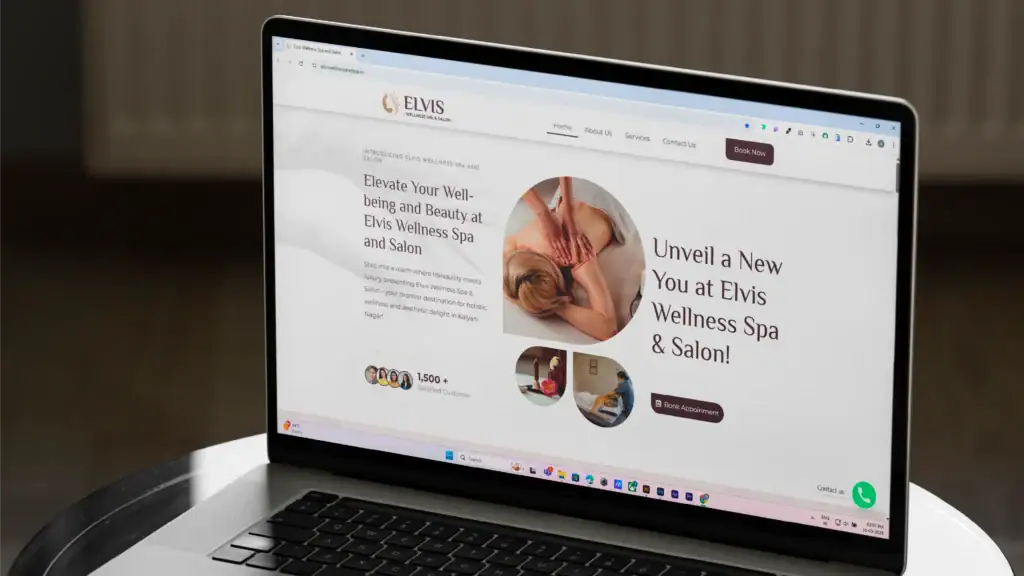
Landing page optimization (LPO) is the process of improving key elements of a landing page—from design to page speed. Using data-driven insights, LPO aims to enhance user experience and maximize conversions.
As a business owner, you must understand that landing pages are critical for your sales funnel. When designed using landing page optimization best practices, landing pages can help secure high-potential leads.
Why It Matters for Your Brand or Business
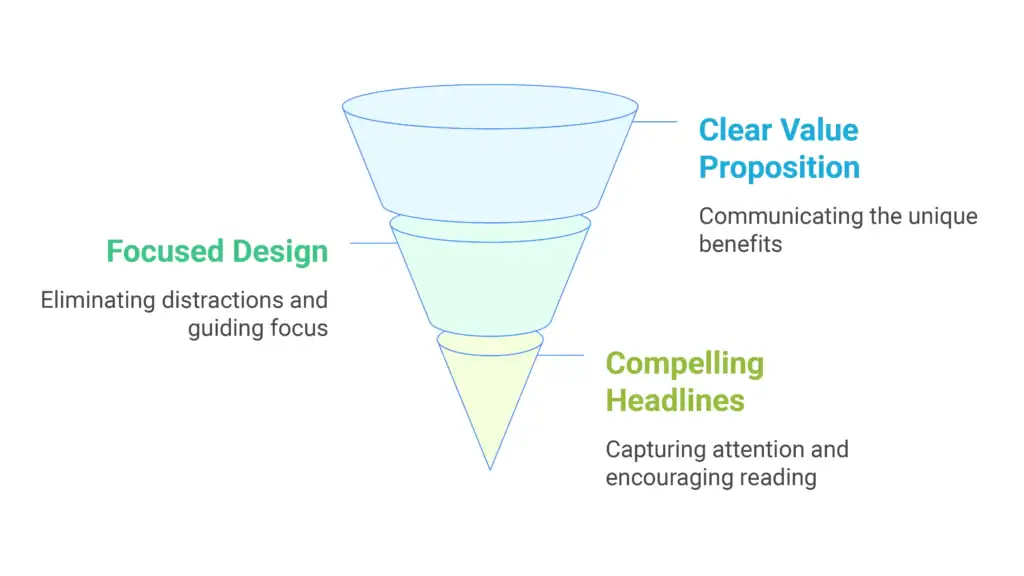
The contrast between an optimized and unoptimized landing page can make a huge difference in your bottom line. Here’s why landing page optimization needs to be a priority:
- Increased conversion rates – Small changes can make a huge difference in your conversion percentages, with more visitors becoming leads or customers
- Reduced acquisition costs – When your landing page performs better, you don’t need to spend as much on advertising to get the same result
- Increased ROI – Higher conversion rates equate to more revenue from the same traffic, maximizing your marketing return on investment
- Enhanced user experience – Optimization will naturally result in clearer, easier-to-use landing pages that create positive impressions of your brand
- Competitive edge – While others accept average results, your optimized pages will continually outperform industry norms
Key Landing Page Optimization Elements
Knowing the key elements that make landing pages succeed will make it easier to concentrate your optimization efforts. The following are the key elements to keep in mind
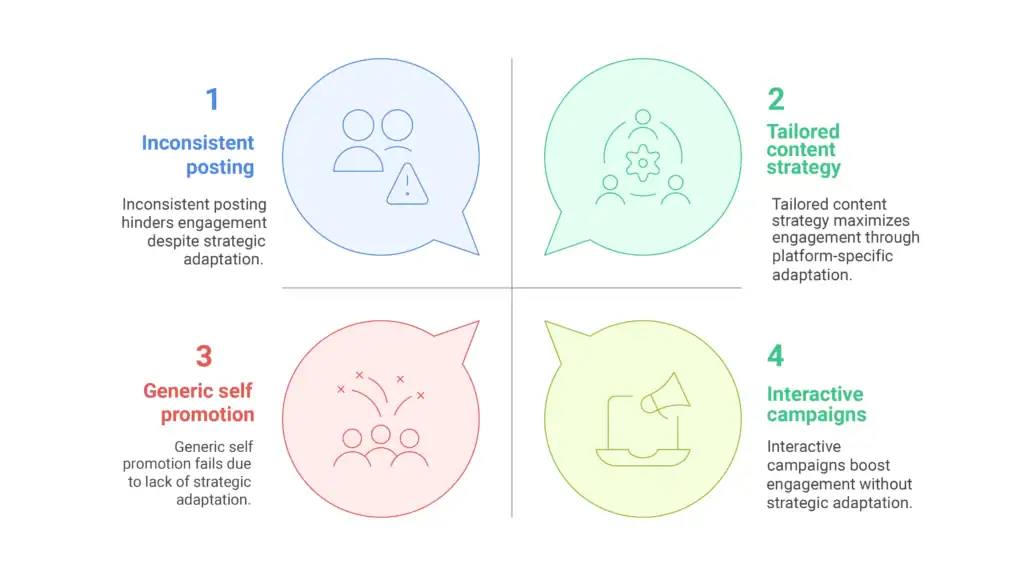
Clear Value Proposition
Your value proposition responds to the visitor’s underlying question: “What’s in it for me?” It must clearly convey the exact benefit your product or service offers and why it’s superior to others.
A good value proposition:
- Is seen prominently above the fold
- Is written in clear, benefit-oriented language
- Clearly addresses your target audience’s pain points
- Makes your offering stand out from others
In optimizing, experiment with various formulations of value proposition to determine what best resonates with your audience. The more distinct your value proposition, the greater the chances that visitors will keep interacting with your page.
Focused Design & Layout
A well-designed landing page removes distractions and points visitors toward your conversion objective. The structure needs to produce a visual hierarchy that directs the gaze naturally from your headline through supporting assets to your call-to-action.
Best practices for optimization are:
- Deleting navigation menus and external links that may direct visitors astray
- Applying whitespace effectively to call out key items
- Producing a coherent visual flow from problem to solution
- Ensuring design elements support rather than compete with conversion goals
Remember that simplicity often outperforms complexity in landing page design. Each element should earn its place by contributing to the conversion goal.
Compelling Headlines & Subheadings
Your headline makes the all-important first impression and will decide if readers will keep on reading. Good headlines speak to your target audience’s main issue or want directly.
Optimizing headlines:
- Test various methods (question, benefit, problem-solution)
- Make them short and scannable
- Make sure they strongly connect with the traffic source messaging
- Break up content and keep readers engaged with subheadings
Titles that directly state what people are searching for always perform better than generic options, so match them to your traffic sources closely.
Persuasive Copy
Your landing page copy reinforces your headline promise by delivering the perfect balance of information to prompt action. The most effective copy addresses the visitor directly, in a relaxed tone, while also resolving common objections.
Copy optimization includes:
- Emphasizing benefits over features
- Writing concise paragraphs and utilizing bullet points for scannability
- Speaking like your target market
- Resolving common questions and objections
The best copy length will vary with the complexity of your offer and price point. More costly or complicated products usually take more explanation than straightforward offers.
Strategic CTAs (Calls to Action)
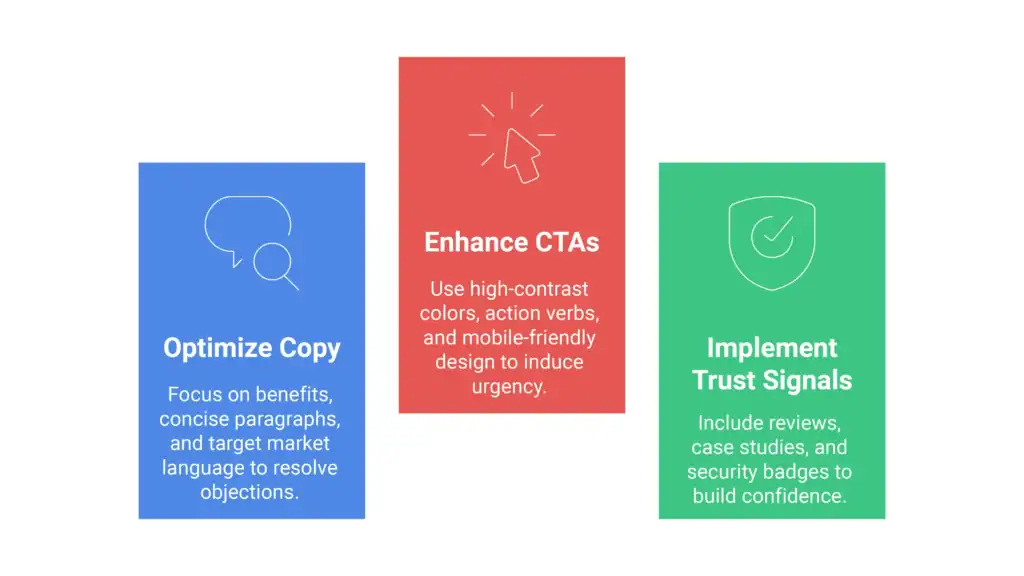
Your call-to-action is the highlight of your landing page—the point where you invite visitors to convert. Great CTAs are noticeable visually and possess action-word language that clearly communicates what occurs next.
For best CTAs:
- Utilize high-contrast colors that really pop off the page
- Utilize action verbs that induce urgency (Get, Start, Join, Claim)
- Ensure buttons are big enough to be tapped on mobile screens
- Experiment with various messaging, sizes, and locations
Having more CTAs on longer pages can bring more conversion opportunities, but these need to all result in the same action to stay focused.
Trust Signals & Social Proof
Consumers require reassurance prior to converting, especially if they don’t know your brand. Trust indicators minimize perceived danger and instill confidence in your product or service.
Well-functioning trust components are:
- Customer reviews and testimonials
- Case studies with measurable outcomes
- Awards and industry certifications
- Privacy assurances and security badges
- Client logos or partner badges
Optimize by testing various forms and placement of social proof to see what best inspires trust with your particular audience.
Step-by-Step Guide to Landing Page Optimization
Refining your landing pages is a constant process and not a single attempt. To achieve this, use the following steps to design an effective approach:
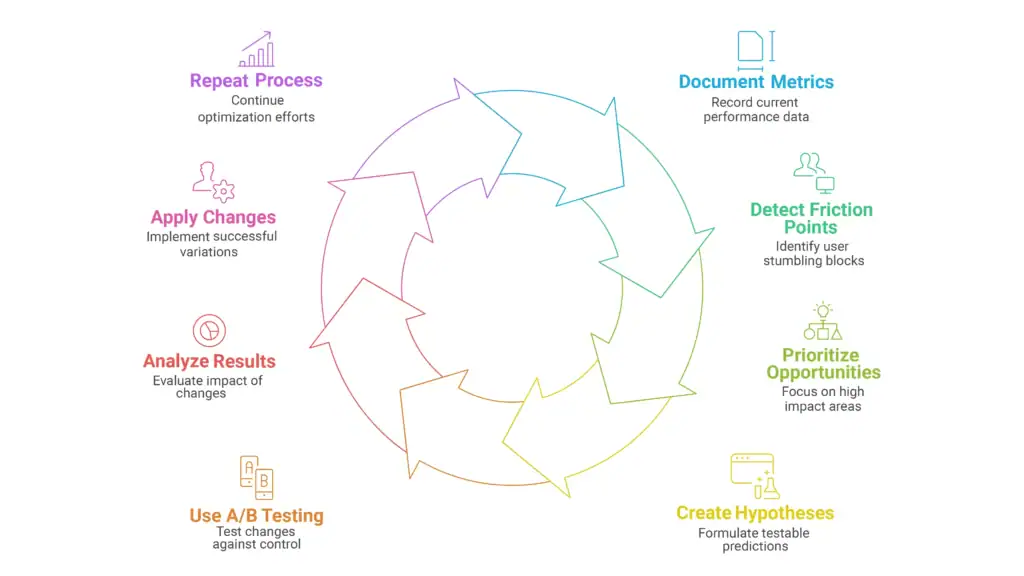
Set baseline metrics
Document your current conversion rate and other most important metrics in order to compare after changes are made.
Detect user friction points
Employ analytics, heatmaps, and session recordings to identify where visitors stumble or drop off.
Prioritize optimization opportunities
Optimize first the things with the greatest potential impact based on data and best practices.
Create test hypotheses
Make specific, measurable predictions regarding how changes will increase performance.
Use A/B testing
Test one variable at a time against your control version to determine what works.
Analyze results deeply
Examine beyond basic conversion rates to see the complete effect of changes.
Apply successful changes
Apply winning variations and record learnings to optimize in the future.
Repeat the process endlessly
Landing page optimization never ends—keep testing to discover further enhancements.
This systematic strategy guarantees your optimization is founded on established success instead of assumptions or fads.
Recommended Tools for Landing Page Optimization
The proper tools have the power to significantly enhance your optimization outcome through improved data and simplified testing. Take a look at these fundamental tools:

Analytics Tools
Google Analytics gives basic information regarding visitor behavior and tracking of conversions. Install goal tracking to track what specific actions users perform on your landing page and build custom reports to target primary metrics.
Heatmap and Session Recording Tools
Software such as Hotjar, Crazy Egg, or Microsoft Clarity offers visualization of how site visitors engage on your page. Check for:
- Where most commonly clicked
- Where they scroll further down the page
- Which of their elements capture most attention
- Where they freeze or exhibit perplexity
A/B Testing Platforms
Tools such as Google Optimize, Optimizely, or VWO make it possible to run tests on variations of your landing page components. Begin with basic tests on high-impact components:
- Headlines and body copy
- CTA button text, color, and position
- Form length and fields
- Images and videos
Page Speed Analysis
Use Google PageSpeed Insights to determine technical enhancements that may lower loading time. Loading speed has a direct effect on bounce rates and conversions, especially on mobile.
Common Landing Page Optimization Mistakes
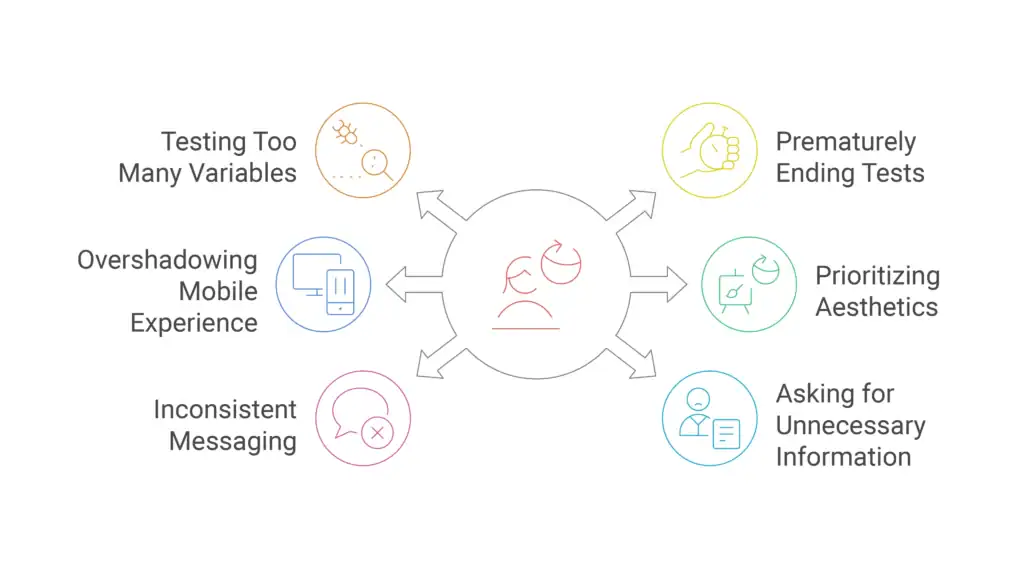
Testing too many variables at once
This renders it impossible to know which adjustments influenced outcomes. Test one variable at a time to see results.
Prematurely ending tests
Statistical significance demands quality traffic and time. Ending tests early implies making untrustworthy conclusions.
Overshadowing the mobile experience
Since most traffic is generated from mobile, optimization should place high emphasis on the mobile user experience.
Prioritizing aesthetics over functionality
Gorgeous design should serve conversion objectives instead of diverting attention from them.
Not being consistent with traffic sources
Your landing page should provide what your ads or links guaranteed, being consistent in messaging.
Asking for unnecessary information
Each extra form field lowers conversion rates. Ask only for what you really need.
Advanced Landing Page Optimization Strategies

After you’ve got the fundamentals down, here are some advanced strategies to maximize results:
Personalization
Customizing landing page content to targeted visitor segments can have a huge impact on conversions. Personalize based on:
Traffic source
- Geographic location
- Return vs. new visitors
- History of interaction with your brand
- Industry or company size (for B2B)
Even basic personalization, like displaying local references or industry-specific examples, can enhance relevance and conversion rates.
Sales Funnel Optimization
Treat your landing page as part of your overall sales funnel. Optimize for the particular stage of the funnel that it’s serving:
- Top-of-funnel pages may be oriented around educational content and lower-commitment conversions
- Middle-of-funnel pages ought to qualify leads and create higher engagement
- Bottom-of-funnel pages must overcome last-minute objections and build a sense of urgency
Every step needs various optimization strategies based on visitor purpose.
Accessibility Considerations
Making your landing pages accessible benefits everyone’s experience, not only people with disabilities. The main accessibility enhancements are:
- Sufficient colour contrast
- Descriptive alt text for images
- Keyboard navigability
- Correct heading structure on content
- Screen reader compatibility with forms
These enhancements guarantee that your landing pages work for all and also assist with SEO objectives.
Post-Conversion Optimization
Conversion isn’t the end. Make the most of what happens immediately post-conversion to:
- Push further actions (cross-sells, upsells)
- Create more profound engagement with your brand
- Create expectations around subsequent steps
- Capture more information slowly
- Turn new leads into influencers through referral schemes
Efficiently designed thank you pages and follow-up chains can significantly maximize the lifetime value of every conversion.
Get expert optimization to convert more traffic into revenue.
Conclusion
Landing page optimization is one of the most impactful tasks for enhancing marketing performance. Through methodical experimentation and optimization of your landing pages based on evidence instead of supposition, you’ll build experiences that convert more visitors into customers.
Keep in mind that optimization is always ongoing—visitor tastes change, competitors get better, and new opportunities arise. The companies that have a culture of testing and optimization will always beat the ones that accept “good enough.”
By using these frameworks and strategies in this guide, you’re ready to design landing pages that not only appear professional but drive measurable business outcomes. Begin with the biggest-impact items, test systematically, and let data inform your choices.
